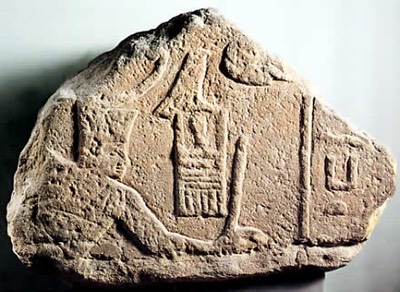The reign of Sanakht and its chronology are somewhat problematic. The Horus Name Sanakht can not be linked with certainty to any of the names mentioned in the kinglists.
Based on a source that contains the Horus-name Sanakht and part of a word that ends with the element ka, it has been suggested that Sanakht was the Horus-name of a king only known in the king-lists, Nebka. The ka sign, however, is part of a word that spells mefkat, meaning ‘turquoise', the main mineral the Egyptians were after in the Sinai.
Sinai Relief showing Horus Sanakht slaying a foe.
Source: Allen e.a., L'art égyptien au temps des pyramides, p. 154.
According to the Turin Canon and Manetho, Nebka was a predecessor of Netjerikhet (Djoser), the founder of the 3rd Dynasty. Other kinglists do not mention Nebka at all, whereas the Papyrus Westcar, listing some predecessors of Kheops, mentions Nebka after Djoser and before Huni.
The archaeological sources however, show that Sanakht must be placed after Netjerikhet (Djoser), more towards the end of the dynasty and probably before Huni. If the identification of the Horus Sanakht with the Nebka from the kinglists is correct and the Turin Canon simply misplaced this king, then it is possible that Sanakht ruled for some 19 years.
Sanakht's name has been found on the island of Elephantine, Egypt's southernmost border, and on a fragmentary relief in the Sinai, where he is shown slaying a foe. Although this is a very traditional pose for a king, it is possible that this relief fragment indicates some military activity by the king in the Sinai region.
Sanakht's name is also present in the remains of a small pyramid built on the island of Elephantine, Egypt's south border at that time. It appears to have been the custom during the reigns of Huni and Snofru to built small pyramids throughout the country. The purpose of these small pyramids is not fully known, but the fact that remains of a similar monument of Sanakht has been found on Elephantine may confirm that he was a predecessor of Huni.
An actual funerary monument for Sanakht has not yet been found or identified as such.
